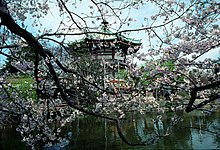Ueno Park

The Ueno Park ( Japanese 上 野 公園 , Ueno Kōen ) is a spacious, public park , which is located in the Taitō district of Tokyo . The park includes the site of the former temple Kan'ei-ji ( 寛永寺 ) located in close connection to the Tokugawa - Shoguns stood. They built the temple on a hill based on the Temple Mount Hiei-zan in the northeast of Kyoto as a symbolic protection of the Edo Castle. The old name of the hill was Shinobu-ga-oka ( 忍 ヶ 岡 ).
History of origin
After the temple complex was largely destroyed during the Boshin War in 1868, the government decided in 1873 to build a park on the site, which could then be opened in 1876. In 1882 the National Museum and the Zoo were opened. In 1890 the park came under the administration of the Imperial Court Office , which in 1924 left it to the city of Tokyo in the name of Taishō - Tennō . The official name of the park is therefore Ueno Onshi Kōen ( 上 野 恩賜 公園 ), which literally means "Ueno Imperial Gift Park".
Attractions
Some buildings from the Edo period have been preserved. First of all, the five-story pagoda of Kan'ei-ji and Ueno Tōshōgū should be mentioned . There is also the Benzaiten shrine in the Shinobazu pond , the Gojō-Tenjinja ( 五條 stat 社 ) with its Inari fox statues in an artificial grotto. A tiny Kiyomizu Kannon- do located on a slope is reminiscent of its model, the Kiyomizu-dera in Kyoto. There is also a (restored) bell tower on the site, the bell of which indicated the time in the Edo period. It is immortalized in a Basho haiku , in German for example:
「花 の 雲 鐘 は 上 野 か 浅 草 か」
"Hana no kumo / kane wa Ueno ka / Asakusa ka"
"A cloud of flowers / the bell, is it Ueno / or even Asakusa?"
The oldest building (1881) of the National Museum , the Imperial Library and the conservatory, which has been restored in recent years, date from the Meiji period .
Later there were other buildings of the National Museum, the National Museum of Natural Sciences , the National Museum of Western Art , based on plans by Le Corbusier and opened in 1959 , the Art Museum of the Tokyo Prefecture and the Tōkyō Bunka Kaikan with its halls built by Maekawa in 1961 (Great Hall 2303 seats , Kleiner Saal 649 seats), in which concerts and theater performances take place. The University of the Arts is also located on Ueno Hill. There is also the Kuroda Kinen- do, which is reminiscent of the painter Kuroda Seiki .
A statue showing Saigō Takamori walking his dog commemorates the influential samurai and leader of the Satsuma rebellion of 1877, who was posthumously pardoned. A little above is a memorial that commemorates the Shogitai, the Tokugawa-loyal troop that was destroyed in the bombardment of Kan'ei-ji in 1868.
In the north of the park is the Ueno Zoo .
Ueno Park with its museums is a popular excursion destination and one of the three or four larger places within Tōkyō, where the Hanami , the short cherry blossom, is celebrated in a convivial get-together under the flowering trees.
The park and its surroundings play an important role in Japanese poetry, including in the novel Gan (Eng .: The Wild Goose ) by Mori Ōgai .
Remarks
- ↑ Flowers = cherry blossoms. Asakusa = Asakusa temple.
- ↑ The building from 1906 survived the Second World War , then became a branch library of the NDL and now operates as the International Children's Library.
literature
- Tōkyō-to rekishi kyōiku kenkyūkai (Ed.): Tōkyō-to no rekishi sampo, shitamachi . Yamakawa shuppansha, 2001, ISBN 4-634-29130-4 .
- Konversationslexikon Kōjien
Web links
Coordinates: 35 ° 42 ′ 44 ″ N , 139 ° 46 ′ 16 ″ E



